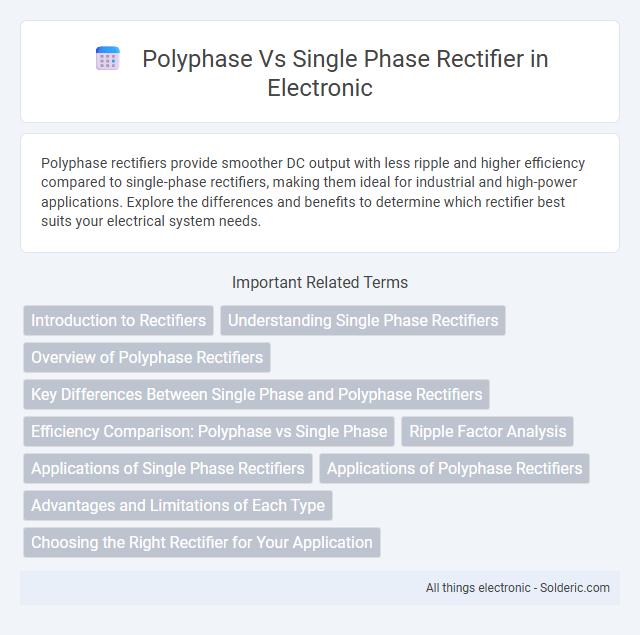Polyphase rectifiers provide smoother DC output with less ripple and higher efficiency compared to single-phase rectifiers, making them ideal for industrial and high-power applications. Explore the differences and benefits to determine which rectifier best suits your electrical system needs.
Comparison Table
| Feature | Polyphase Rectifier | Single Phase Rectifier |
|---|---|---|
| Input Phases | Multiple AC phases (usually three) | Single AC phase |
| Output Ripple | Low ripple voltage | High ripple voltage |
| Efficiency | Higher efficiency | Lower efficiency |
| Transformer Size | Smaller due to balanced loads | Larger, bulkier transformers needed |
| Power Capacity | Handles high power load | Suitable for low to medium power |
| Complexity | More complex circuitry | Simple design and implementation |
| Applications | Industrial power supplies, HVDC, large motors | Battery charging, small appliances |
Introduction to Rectifiers
Rectifiers convert alternating current (AC) to direct current (DC), essential for powering electronic devices. Single phase rectifiers use one AC waveform, suitable for low-power applications but with higher ripple in output voltage. Polyphase rectifiers utilize multiple AC phases, delivering smoother DC with less ripple, making them ideal for high-power and industrial uses where efficiency and stability are critical for your equipment's performance.
Understanding Single Phase Rectifiers
Single phase rectifiers convert AC voltage to DC voltage using one or two diodes, commonly found in low power applications such as household electronics and small power supplies. They produce a pulsating DC output with relatively high ripple, requiring additional filtering to achieve smooth DC voltage. Their simplicity makes them cost-effective but less efficient for high power or industrial uses compared to polyphase rectifiers.
Overview of Polyphase Rectifiers
Polyphase rectifiers convert AC power from multiple phases into DC, providing smoother output with reduced ripple compared to single-phase rectifiers. Commonly used in industrial applications, they enhance efficiency by distributing the load across several phases, improving power quality and reducing harmonic distortion. Your choice of a polyphase rectifier ensures better performance in high-power systems requiring stable and continuous DC supply.
Key Differences Between Single Phase and Polyphase Rectifiers
Single-phase rectifiers convert AC to DC using a single alternating voltage source, resulting in larger ripple voltage and lower efficiency, while polyphase rectifiers utilize multiple AC phases to provide smoother DC output with reduced ripple and higher efficiency. Polyphase rectifiers offer improved performance in power handling, waveform quality, and reduced harmonic distortion compared to single-phase rectifiers. The choice between single-phase and polyphase rectifiers depends on application requirements such as power capacity, load stability, and cost constraints.
Efficiency Comparison: Polyphase vs Single Phase
Polyphase rectifiers offer higher efficiency compared to single-phase rectifiers due to reduced ripple voltage and better utilization of transformer capacity. The continuous power delivery in polyphase systems results in lower losses and improved thermal performance, enhancing overall conversion efficiency. Single-phase rectifiers exhibit greater harmonic distortion and require larger filtering components, which can reduce energy efficiency in power conversion applications.
Ripple Factor Analysis
Polyphase rectifiers exhibit significantly lower ripple factors compared to single-phase rectifiers, resulting in smoother DC output and reduced filtering requirements. The ripple factor in single-phase rectifiers typically ranges between 0.48 to 1.21, whereas in a three-phase polyphase rectifier, it can drop below 0.10 due to overlapping conduction intervals. Understanding this difference allows you to select rectifier designs that minimize voltage fluctuations and enhance power quality in your applications.
Applications of Single Phase Rectifiers
Single phase rectifiers are commonly used in low-power applications such as household electronics, battery charging, and small DC motor drives where simplicity and cost-effectiveness are essential. These rectifiers convert AC voltage to DC voltage efficiently for devices like televisions, radios, and LED lighting systems. Their compact design and ease of integration make them ideal for consumer appliances and small-scale industrial equipment.
Applications of Polyphase Rectifiers
Polyphase rectifiers are widely used in industrial applications requiring high power and efficiency, such as electric motor drives, HVDC transmission systems, and large-scale battery charging stations. These rectifiers provide smoother DC output with reduced ripple, making them ideal for precision applications in manufacturing and renewable energy integration. Your system benefits from improved power quality and reduced harmonic distortion when employing polyphase rectification technology.
Advantages and Limitations of Each Type
Polyphase rectifiers provide higher efficiency and smoother DC output with reduced ripple compared to single-phase rectifiers, making them ideal for industrial applications requiring stable and high power. Single-phase rectifiers offer simplicity, lower cost, and easier maintenance but suffer from higher ripple and lower efficiency, limiting their use to low-power applications. Polyphase systems necessitate more complex circuitry and higher initial investment, while single-phase systems face limitations in power handling and output quality.
Choosing the Right Rectifier for Your Application
Choosing the right rectifier for your application depends on power requirements and efficiency needs; polyphase rectifiers provide smoother DC output and higher power capacity compared to single-phase rectifiers. Single-phase rectifiers are suitable for low-power devices with simpler designs, while polyphase rectifiers are preferred in industrial settings requiring minimal ripple and enhanced performance. Understanding your load characteristics and voltage stability is crucial for optimizing rectifier selection and ensuring system reliability.
Polyphase vs Single Phase Rectifier Infographic

 solderic.com
solderic.com